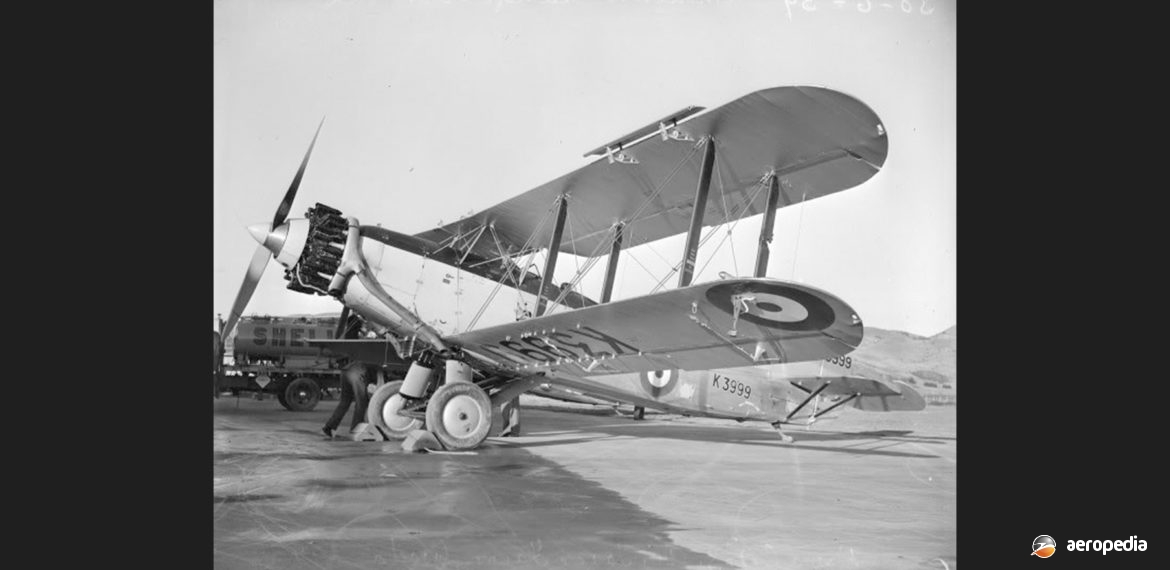Photograph:
Fairey Gordon K3999 whilst in RNZAF service (RNZAF Museum)
Country of origin:
United Kingdom
Description:
Two-seat light day-bomber and general-purpose biplane
Power Plant:
One 392 kw (525 hp) Armstrong Siddeley Panther IIa fourteen-cylinder air-cooled radial engine
Specifications:
- Wingspan: 13.94 m (45 ft 9 in)
- Length: 11.18 m (36 ft 8⅝ in)
- Height: 4.87 m (14 ft 2⅜ in)
- Wing area: 40.73 m² (438.5 sq ft)
- Max speed at 915 m (3,000 ft): 233 km/h (145 mph)
- Cruising speed: 177 km/h (110 mph)
- Service ceiling: 6,705 m (22,000 ft)
- Initial rate of climb: 305 m/min (1,000 ft/min)
- Range: 966 km (600 miles)
- Empty weight: 1,588 kg (3,500 lb)
- Loaded weight: 2,679 kg (5,906 lb)
Armament:
One 7.7 mm (0.303 in) Vickers fixed forward firing machine gun, and one 7.7 mm (0.303 in) Lewis machine gun on pivoting mount in rear cockpit; up to 227 kg (500 lb) of bombs carried on underwing racks
History:
The Fairey Gordon was a development of the Fairey IIIF, and in fact was originally known as the Fairey IIIF Mk V, but had the Armstrong Siddeley Panther engine in lieu of the Napier Lion. The Gordon was ordered as a daylight bomber and general-purpose aircraft for the Royal Air Force (RAF), the first of the type flying on 3 March 1931. Some 185 were built, production concluding in 1934, and amongst the total was a number of trainer variants. Subsequently about 90 Fairey IIIFs were converted to Fairey Gordon configuration, and a number were sold overseas, including 20 new aircraft to Brazil, one to China, and ex-RAF aircraft to Egypt and New Zealand.
A total of 41 Gordons saw service with the RNZAF, 24 being received in June 1939 and 16 in September 1939, being assembled at Hobsonville. Of these 25 were Mk Is and the remainder Mk IIs, the latter having a re-designed taller and more rounded fin and rudder. The first two aircraft were received at Wigram in July 1939. Serials NZ 601 to NZ641 (c/ns in the range from F.1305 to F.1963) had been allocated and they saw service until 1942 when, in August, scrapping commenced, the last being broken up in July 1943, this being NZ621.
The Gordon replaced the Vickers Vildebeest in service with No 1 Flying Training School (FTS) at Wigram and, as they were essentially for training duties, they remained in the RAF overall silver colour scheme with black trim. The Gordons had seen much service before arriving in New Zealand, at least one serving in the Middle East, and the airframes and engines required a lot of work to keep them airworthy. Many had engine failures in service and made forced landings on the Canterbury Plains.
In 1941 North American Harvards commenced to arrive for advanced training and the Gordons were retired, most being scrapped during 1942 and 1943, although a couple were converted for use as target tugs. Three are known to have become Instructional Airframes, NZ626 to INST12, NZ639 to INST 14, and NZ626 to INST 14. It is interesting to note some of the Gordons operated with their RAF serials and it was only after they were written off in accidents that the RNZAF serial was allotted; eg, K4002, which crashed on 3 November 1939, later became NZ612.
The 41st aircraft (NZ641) is believed to have been built from a number of wrecks. Ten were lost in service due to accidents. One of these (NZ629) crashed in wooded country at an altitude of 1,219 m (4,000 ft) above the Poulter River in Arthur’s Pass in the Canterbury area on 12 April 1940 and in 1975 the remains were salvaged and taken to Auckland where long term plans by Pioneer Aero Restorations were to restore the aircraft to airworthiness. To this end registration ZK-TLA was reserved on 29 February 1988.
The sole surviving Gordon was attached to No 1 Flying Training School at Wigram when it crashed on 12 April 1940 on a flight above the New Zealand southern alps. The crew survived but was injured. The wreck was stripped by the RNZAF and in 1979 a group recovered the remains, placing them in storage. It was eventually exported to the United Kingdom where work has proceeded on its restoration to display standard.

